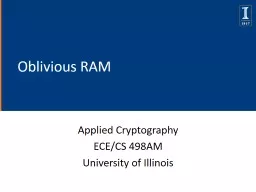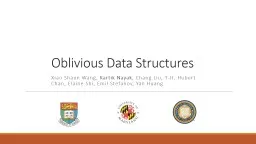PPT-Oblivious RAM Applied Cryptography
Author : lois-ondreau | Published Date : 2018-03-17
ECECS 498AM University of Illinois Problem Software piracy Oded Goldreich Existing solutions are adhoc What is the minimal protected hardware required Approach
Presentation Embed Code
Download Presentation
Download Presentation The PPT/PDF document "Oblivious RAM Applied Cryptography" is the property of its rightful owner. Permission is granted to download and print the materials on this website for personal, non-commercial use only, and to display it on your personal computer provided you do not modify the materials and that you retain all copyright notices contained in the materials. By downloading content from our website, you accept the terms of this agreement.
Oblivious RAM Applied Cryptography: Transcript
Download Rules Of Document
"Oblivious RAM Applied Cryptography"The content belongs to its owner. You may download and print it for personal use, without modification, and keep all copyright notices. By downloading, you agree to these terms.
Related Documents














